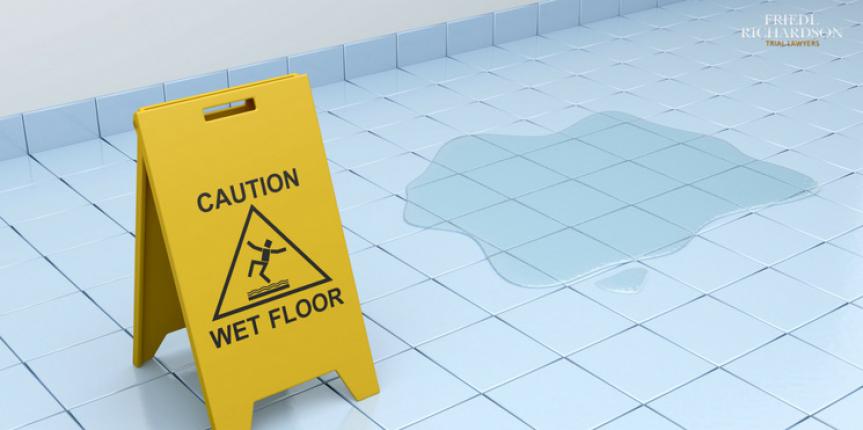Slip And Fall Injuries: Causes, Risks, And Taking Action
Slip and fall incidents occur with alarming frequency. The National Floor Safety Institute reports that over one million annual United States slip and fall incidents result in emergency room visits. Often, these traumatic injuries are prompted by negligence on the premise owner's behalf.
Slip and Fall Causes
Slip and fall accidents can be caused by a variety of circumstances. From torn carpet to puddles, it's the premise owner's responsibility to maintain safe and easily navigable conditions so as to prevent slip and fall accidents. The following are a few of the most common causes underlying these devastating incidents:
Wet or Slippery Indoor Surfaces
Evidence from the National Floor Safety Institute suggests that hazardous surfaces prompt 55 percent of slip and fall accidents. Often, surfaces are wet (and therefore slippery) due to spills or recent mopping. Employers must either take action to dry hazardous surfaces or warn visitors of potential hazards.
Adverse Weather Conditions
Although it's impossible to control the weather, property owners should respond to adverse conditions promptly and responsibly. This means clearing off icy or snowy walkways and cleaning up debris (such as fallen branches) after storms. Accuweather highlights 'unnatural accumulation' as a key term in these slip and fall cases. For example, property owners may be held liable if icicles hanging from awnings drip and refreeze as sidewalk puddles, leading to new hazards.
Clutter
Clutter can prove surprisingly hazardous. Property owners — especially business proprietors — must keep premises free of obstructions that could prompt injuries among customers or employees. Clutter issues are particularly common in poorly-staffed stores, where merchandise can cause accidents if strewn about or not returned after customer handling. Trailing cords also prompt many falls.
Poor Construction or Maintenance
Structures must be constructed according to local code, which addresses a variety of potential hazards. Additionally, property must be maintained so as to reduce the risk of injury. Examples of poor maintenance include loose floorboards and torn carpeting.
Stairs present additional challenges; falls may result from improper stair height or lack of quality handrails. Premise owners may also be accused of negligence if stairs feature slippery materials or worn carpet.
Common Slip and Fall Injuries
Slip and fall incidents lead to several devastating injuries. Examples include:
- Hip fractures
- Ankle sprains
- Lacerations
- Herniated or slipped discs
- Shoulder dislocation
- Head injuries
In severe cases, slip and fall accidents may result in wrongful death. For example, a Daily Business Review story highlights Majic Cleaning Systems as liable for the death of Qurris Walker, who slipped on wet floor in the lobby of Orlando's Rosen Shingle Creek Hotel. The fall led to surgery, which, ultimately, led to the clogged tracheal tube that caused the victim's death. Wrongful death claims may also arise if falls lead to spinal cord paralysis or severe head injuries.
Taking Action
If you believe your recent slip and fall accident was prompted by negligence, you may be eligible for damages. It's imperative that you seek medical attention as soon as possible; not only will this minimize damage to you personal health, it will also provide much-needed documentation for your later personal injury case.
Once you complete your medical evaluation, contact a personal injury attorney with a strong track record in slip and fall representation. Prompt legal counsel is imperative; the personal injury statute of limitations is two years in Arizona, but it can take months, even years to gather evidence and build a strong case.
If your attorney determines that you have a viable personal injury case, you may be asked to provide additional verification of your injury and the impact it has had on your daily life. Ample evidence will be needed to prove negligence; this may include demonstrating that the responsible party knew of the problem and failed to take action.
Depending on your case, you could emerge from the personal injury process with several types of damages. Compensation for medical bills is most common; this may cover hospitalization, medication, medical equipment, and ongoing rehabilitation. If your injury is severe enough to render you unable to work, damages for loss of wages may also be possible. Damages could also cover emotional duress. Punitive damages are rare in slip and fall accidents, but may be awarded in cases involving malicious intent.
Far too many premise owners fail to maintain safe conditions. Thankfully, it's possible to hold these negligent businesses and individuals accountable. Slip and fall claims can provide deserved compensation while also sending a clear message that everyday individuals won't turn a blind eye to injury-inducing negligence.






